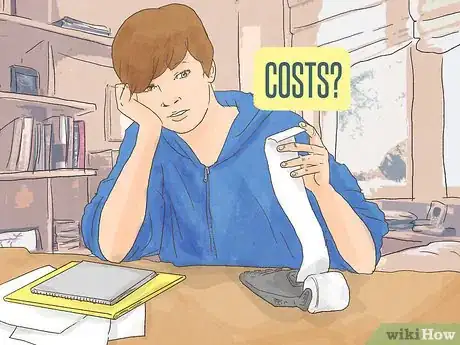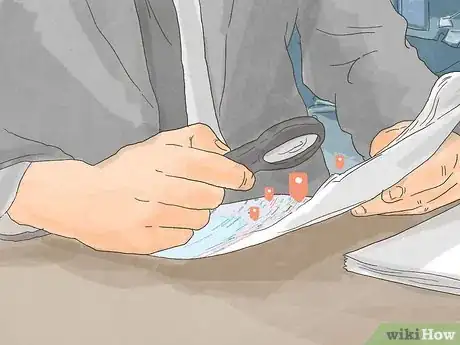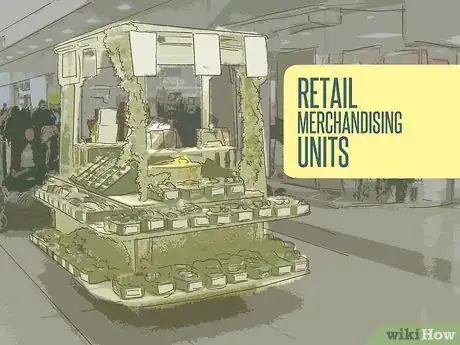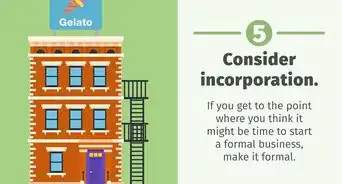This article was co-authored by Gina D'Amore. Gina D'Amore is a Financial Accountant and the Founder of Love's Accounting. With 12 years of experience, Gina specializes in working with smaller companies in every area of accounting, including economics and human resources. She holds a Bachelor's Degree in Economics from Manhattanville College and a Bookkeeping Certificate from MiraCosta College.
wikiHow marks an article as reader-approved once it receives enough positive feedback. In this case, 100% of readers who voted found the article helpful, earning it our reader-approved status.
This article has been viewed 172,660 times.
Opening a retail store in a shopping mall can give you immediate access to an existing flow of potential customers. In addition, your store can benefit from the amenities and structures that already exist in the mall, freeing you from having to create your own. That said, for many stores, the mall is full of competitors that sell similar products. This means that you'll have to price your products competitively and draw customers into your store. Setting up a store in this way is relatively straightforward if you use the following steps.
Steps
Planning Your Store
-
1Analyze the mall. Your first step, once you have chosen a mall to sell in, is to get an idea of what kind of customer frequents that mall and what the other stores in it sell. Visit the mall to see its foot traffic and understand its demographics. Does it sell upscale, moderate, or budget items and services? Your goal should be to assess how well your store concept fits within the bounds of the present demographics of the mall.
- For example, a store selling expensive, handmade men's shoes would not do well in a mall frequented by mostly lower-income customers.
-
2Determine what you will sell. When you're setting up a mall retail store, remember that you're not trying to sell items that you would necessarily want to buy, but items that will sell well in that mall. Start by identifying a need in the mall or the local market. This can be either a specific product need or an underserved demographic group. After identifying a need, assess your ability to fulfill that need with your store, including your ability to make a reasonable profit selling these items.
- For example, an underserved demographic in a given market might be plus-size people or Latin Americans. If you notice a lack of stores serving a particular group in the mall, consider building your offerings around that group.[1]
Advertisement -
3Understand the requirements. Before doing anything else, you will have to make sure that your business plan fits within the scope of what the mall allows. The mall may have specific rules and regulations that prevent certain business types from operating there. Make sure to contact the mall owner or office for a copy of these regulations and use them when planning your lease and, later, the interior of your store.
-
4Decide whether or not to franchise. It may be a good idea to purchase a franchise of a well known retail business, as most malls prefer to lease space to businesses that have a reputation in the market with a loyal customer base. In addition, your franchise will come complete with a business plan and national advertising to bring customers in the door. However, that doesn't mean that the work is done for you; you still have to work to make the the business a success.[2]
- A franchise may be relatively simpler to open, but will limit your own freedom to make business choices. In addition, you usually have to pay a large, upfront franchise fee and make regular payments to the franchisor.
-
5Name your store. Unless you are franchising an existing business, you will have to come up with a name for your store and for the legal entity that is your business. Your store's name is one of its most important aspects, so make sure you choose a good one. After all, this name will be on your storefront and will be what your customers know your business as. Try to pick something that relates to what your business does or sells. In addition, make sure that your name is clear, inoffensive, and spelled properly.
- Your store name should be trademarked.
- Your business name, on the other hand, is the legal name of your business, used on official documents like taxes and your lease contract. If your business is a sole proprietorship, your name is the business name.
-
6Decide on your business organization. Your business organization is the structure of your business and decides how you are taxes and how your profits are handled. If you alone are the owner of your business, you can choose either a sole proprietorship or a limited liability corporation (LLC). The LLC choice removes you from personal liability for your business's debts and is usually a better option. However, it's best to consult with a legal professional when setting up your business organization to determine your best option.
-
7Figure out what licenses or permits you need. Check with your local Small Business Administration (SBA) office or your city chamber of commerce to figure out what licenses or permits you need for your store. The mall may also be able to help you with this. The specific permits you need will depend on what you are selling or providing to your customers. However, you will usually need to register with your state to charge sales tax.
-
8Hire professional help. When going through this process, you will need professional help from at least three different sources. For one, you will need a lawyer who can advise you on the legitimacy and fairness of any agreements or lease contracts that you are offered. Next, you will need a retail financial specialist that can set up your books for record keeping and tax collection according to state tax law. Then, before you open, you may also want to pay for the services of a professional interior designer, floor planner, or merchandiser to give your store a professional layout and organization.[3]
Working Out Your Finances
-
1Write a business plan. Your business plan is your general strategy for operating your store and making money. In general, you will need to start a business plan by stating your business's objective, or what service or product it seeks to provide to the customer. Include such details as your target audience or customer, your specific product or service offerings, and your marketing strategies. The rest of the business plan should focus on finances, like your planned startup budget, inventory costs, and any additional costs, like insurances, taxes, wages, and rent.
-
2Understand all the costs. When opening a retail store, you will need to pay a number of expenses involved in getting your business off the ground. The first, and most obvious, expense is your storefront lease. Start by assessing generally how much you expect your space to cost each month. Contact the mall for preliminary pricing for several different available storefronts so that you can compare several options. Keep in mind to include insurance, your deposit or down payment, and utilities in your lease expenses.
- Some places may ask for multiple months of utility and rent payments upfront.
- Next, work with a floor planner and interior designer to determine the cost of upgrading the interior of your store to meet your needs.
- Consider other expenses you will have to pay before opening, like any materials you will have to buy and inventory costs. Also, consider technology costs—you'll have to purchase some method of collecting payments from your customers.
- Finally, think about monthly expenses you might have, such as paying employees and spending on marketing or public relations.[4]
- Understand the difference between a fixed cost and a variable cost.
- The costs that do not change every month are called fixed costs. For example, the rent, utilities, and payroll.
- The costs that change every month, such as marketing expenses, are known as variable costs.
-
3Figure out your financing source. Your options in financing your store are many. The cheapest option (in the long run) is to finance your own start up costs. This allows you to avoid paying any interest on a business loan or splitting your profits with a partner or investor. However, in many cases this is simply not possible. To get a small business loan, consider working with a local bank or applying for a loan with the Small Business Administration (SBA). You can also attempt to gain an investor or partner that has the funds to contribute to get your business off the ground. Consider which options works best for you and your business by weighing the costs and benefits of each.
- For more, see how to fund a business.
-
4Set up a business bank account. You will have to open a separate bank account for paying your lease and for accepting payment from customers. Contact several banks close to the mall and ask about their small business programs. Get a list of services they offer to business and fees that they charge and then use this information to choose the best account for your purposes. You should also take into consideration how safe you feel in the bank and about taking your money there.
Deciding on a Location
-
1Figure out how much space you need. You'll need to find a space within the mall that meets your needs as a store. Of course you can spread out or bunch up your products to fit within a space, but it is best to have a natural amount of room in your store. Again, consult with a floor planner to figure out how much space you will need to display your inventory. You'll also need to think about space for a stockroom, office, or dressing rooms, depending on the type of products or services you will offer.[5]
-
2Look for the best available location. If you find that the mall has several open spaces that meet your space and budget requirements, you'll have to decide which space to choose. The main consideration you should have in a mall is your placement versus your competitors. While it may seem illogical, you want to be near your competitors if possible. This guarantees that customers shopping for products that both you and your competitor sell will go to that area of the mall.[6]
- You should also try to locate your store near complementary stores. For example, a jewelry store might want to locate next to an upscale department store. That way, the stores can attract customers to the same corner of the mall together and both benefit from the targeted traffic they receive.
-
3Consider using a kiosk or cart. If you're not an experienced retailer, opening a full-fledged retail storefront might not be your best option. Instead you can invest a smaller amount of money and work out of a kiosk or mall cart. These options allow you to gain business know-how and experience without the risk and expense of a full storefront.
- Kiosks sit in the middle of mall concourses and usually showcase smaller goods, like phone accessories, jewelry, or watches.
- Mall carts, also called retail merchandising units (RMUs), are smaller than kiosks and are located in common areas within malls. They allow for displays of smaller items and can be used to provide simple services like engraving or watch repair.
-
4Negotiate a lease. When you've selected your space, you'll have to negotiate your lease with the mall. At this point, it's best to retain the services of an attorney with retail lease experience. The contract offered to you by the mall will be full of special conditions, regulations, and other confusing concepts that can be best untangled by an attorney. The terms discussed in these negotiations include costs, like utilities and maintenance costs, and also loan terms, like a reduced loan rate during the remodel period and a conflict resolution process for you and your landlord. Work with your lawyer to ensure that your interests are protected in the contract.[7]
-
5Finalize your lease. After proper analysis you can finalize the deal. Get everything in writing and show the agreement to your lawyer before signing it to make sure nothing has been changed.
Opening for Business
-
1Acquire your merchandise. If you are selling products rather than services, you will need purchase inventory before you can open for business. If you already have inventory selected, work out vendor agreements with wholesalers or producers of those items. Otherwise, you will have to visit trade shows for your industry to locate the newest and best products to sell. This allows you to see many suppliers in a short period of time. In addition, you can use trade shows as an opportunity to learn about industry trends and network with other store owners.[8]
-
2Design the inside of your business carefully. Work with an interior designer to perfect the feel of the inside of your store. Think about lighting and decorations in every part of the store. Also think about music you will play and what smells, if any, you will seek to create. Use all of these different aspects of your store to create a mood that fits with your target customers and your product.
- Remember to create a place for your most important or fastest-selling inventory in a dominant position at the front of the store, right in front of the door.[9]
-
3Hire employees. Create a job posting and place it in your local newspaper and online on job search websites and Craigslist. You can also place a "now hiring" sign in the window. In your job posting, make it clear that you want workers experienced with retail, and preferably in your specific type of retail. Make sure that they are familiar with the product or willing to learn about it. Interview each potential employee to make sure that they are polite and fit with the culture of the store.[10]
- Even experienced retail employees will need training in your specific products and in how you wish them to interact with customers.
-
4Make sure your operations are in order. Before you open, check over everything again. Make sure your licenses and permits are all in order and processed with the government. Check that your method for accepting payments is functioning. Check your inventory for content and presentation. Assess your employees' readiness for opening and running operations.
-
5Hold a grand opening. Advertise your new store in the newspaper or on tv before your opening. Hold some sort of event to get customers in the door. For example, you could offer a free gift with a purchase or something similar. Just make sure it is a big event that grabs the attention of customers walking around the mall.
- Alternately, you can hold a "soft opening" first, where systems and employees are tested before announcing a grand opening. This guarantees that your store is properly functioning before the grand opening.
Community Q&A
-
QuestionCan I open a business inside a dead mall?
 Community AnswerYou can open a store in any mall that will still rent you a storefront. However, by opening a store in a dead mall, you will not benefit from the foot traffic present in highly occupied malls.
Community AnswerYou can open a store in any mall that will still rent you a storefront. However, by opening a store in a dead mall, you will not benefit from the foot traffic present in highly occupied malls. -
QuestionWhy are malls the best place to open a store ?
 Community AnswerLots of people go there specifically to shop. Also, it would be easier to find you than at a other area.
Community AnswerLots of people go there specifically to shop. Also, it would be easier to find you than at a other area. -
QuestionI am starting up a supermarket at a filling station. How and where do I purchase my products into the shop?
 Community AnswerYou would have to get it from a supplier or from a local farmer. Depending on what you would like. Look up a supplier in your area that provides the items you need.
Community AnswerYou would have to get it from a supplier or from a local farmer. Depending on what you would like. Look up a supplier in your area that provides the items you need.
Expert Interview
Thanks for reading our article! If you'd like to learn more about investments, check out our in-depth interview with Gina D'Amore.
References
- ↑ https://www.nypl.org/sites/default/files/retail_101_nypl_copy.pdf
- ↑ http://www.inc.com/guides/2010/05/choosing-a-franchise-location.html
- ↑ https://www.nypl.org/sites/default/files/retail_101_nypl_copy.pdf
- ↑ http://www.inc.com/articles/201108/business-start-up-costs-retail-store.html
- ↑ http://fitsmallbusiness.com/lease-retail-space/
- ↑ http://fitsmallbusiness.com/lease-retail-space/
- ↑ http://fitsmallbusiness.com/lease-retail-space/
- ↑ https://www.nypl.org/sites/default/files/retail_101_nypl_copy.pdf
- ↑ https://www.nypl.org/sites/default/files/retail_101_nypl_copy.pdf
About This Article
Starting up a retail store in a shopping mall is a lot of work, but you can set yourself up for success with the right location and products. Identify a need in the mall or your local market that you can fill. It could be a product such as plus-sized jeans, or a service such as a shoe repair shop. Then, write a business plan that lays out your strategy for operating the store and how you’ll turn a profit. Choose the best available location that meets your space and budget requirements. If you can’t finance your own start-up costs, contact a local bank or apply for a small business loan. You’ll also need to purchase inventory from wholesalers or producers of the items you plan to sell. You can also visit trade shows for your industry to find new, quality products that you can sell. For tips about how to design the inside of your business in a shopping mall, keep reading!




















































































